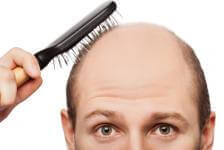What Causes Hair Loss?
Learn why women lose their hair, what you can do to re-grow yours, and when it might be time to see your doctor.

So when women lose hair, it’s a big deal. Women know when they are losing hair, even if it is not visible to the outsider, and it can be worrisome, saddening, and even traumatizing.
What Causes Hair Loss?
Andrea came to my office in tears. She had always had a full head of hair, and within the last six months she’s noticed quite a drastic change—an overall thinning of her hair. She wanted to know why she was losing so much hair. I’ll tell you what I told her; there are 7 common causes of alopecia, otherwise known as hair loss:
-
Genetics: This is by far the most common cause of hair loss. Genes are responsible for hair loss in both men and women, and hair loss related to genetics may begin as early as age 12. The loss of hair is diffuse and all over the entire scalp–and not just in one spot or patch;–but is worse in the front or sides of the scalp. Andrea’s dad suffers from male-pattern baldness.
-
Pregnancy: Many women lose some hair throughout the pregnancy or after delivery. This is usually reversible, and most regrow their hair with time. Andrea was not pregnant.
-
Thyroid Disorders: Many patients with abnormal thyroid hormone levels can experience hair loss. Andrea’s blood test for a thyroid condition was normal.
-
PCOS: Elevated testosterone levels cause a diffuse thinning of the scalp in women, and that’s why many women with Polycystic Ovarian Syndrome, a condition marked by irregular periods, acne, and abnormal facial/body hair experience hair loss. Andrea’s periods are regular, and she has never had a problem with acne or excessive body/facial hair. To read more about PCOS, refer to my previous article, “What is Polycystic Ovarian Syndrome (PCOS)?
-
Autoimmune Attack: The body can produce certain proteins that attack its own hair follicles. Patients with this type of hair loss typically have a very distinct area of hair loss, and the rest of the scalp is unaffected. But Andrea’s hair loss was diffuse, and she didn’t have any distinct pattern of hair loss.
-
Damaged Hair Follicles: A number of things can damage the hair follicles:
- chemicals applied to the scalp
- infections of the scalp
- radiation or chemotherapy
- certain crash/liquid protein diets
- medications (like hormones and anti-seizure medications)
Andrea told me that none of those applied to her
-
Stress: Stress can also cause a rather diffuse pattern of hair loss all over, and the hair loss typically begins 2-4 months after experiencing a rather traumatic stressful life event. It can last several months, but it is reversible. With time, most women regrow their hair. Andrea finally confessed that she broke up with her boyfriend of eight years about three months ago and has been very depressed since. We have our cause.
How Can You Treat Hair Loss?
I told Andrea that her sudden hair loss is likely from the emotional trauma and stress she experienced, and that it will likely improve with time. But as I told her, there are certain treatment options you can use to treat hair loss:
-
Multivitamins: Take a prenatal vitamin every day (even if you are not trying to get pregnant) will ensure that you are getting the right amount of nutrients and vitamins necessary for good hair and nail growth.
-
Minoxidil: A medication initially used to treat high blood pressure was discovered to have an interesting side effect—it caused hair growth. Now this drug, called Monoxidil, commonly known as Rogaine, is formulated and marketed specifically to regrow hair. Minoxidil is an over the counter medication and it must be applied to the scalp twice daily. It does work, and works really great for many people, but it typically takes about three months to start noticing the difference. There is a traditional “female” 2% dose and “male” 5% dose. However, if your hair loss is significant, women can safely use the 5% “male” dosing. Most common side effect? Some women report a little bit of hair growth on the face (don’t worry, this is reversible once you stop using the product). And if you do stop the treatment, hair loss will likely return. You can get this at any drug store or pharmacy on your own without a prescription from a doctor!
-
Steroid injections or creams: If your hair loss is in a distinct pattern and the earlier mentioned treatments don’t work, see your personal doctor or a dermatologist for possible injections of steroids, or prescription steroid creams to apply to the scalp.
-
Spironolactone: Another medication originally developed to treat high blood pressure, Spironolactone is now used to treat some women with hair loss secondary to PCOS. If taken, women must use a reliable method of birth control, as it may cause congenital abnormalities in fetuses.
-
Retin-A: There are a few studies that suggest using good ole Retin-A as an adjunct to Minoxidil can help treat those with a distinct hair loss patch (As I mentioned in my article, “4 Common Skin Problems: How to Deal,” (Retin-A is also used to treat acne and improve wrinkles).
What About Propecia?
You may have seen advertisements for the hair loss drug, Propecia, but unfortunately, this oral medication is only used to treat men with hair loss, mostly because it can cause abnormal genitalia in the male fetuses of women who get pregnant while taking it.
When Should You See Your Doctor About Hair Loss?
Hair loss can be treated over the counter, but there are certain times when you should definitely see your doctor:
-
If the over-the-counter methods don’ t work
-
If your hair loss is not just diffuse, but in a distinct circular or oval pattern
-
If your hair loss seems significant, or is getting worse with time
-
If it is caused by any new medications you may have started
-
If you experience any problems with your periods, or also suffer from acne
-
If you have any signs of thyroid disorders, such as constipation, fatigue, depression, and weight gain
I saw Andrea about four months later, and even though she declined the various treatments of alopecia, she had already started to regain some of her hair loss. She is also dating again and is involved in a new romantic relationship which she is excited about—go Andrea!
If you didn’t know, the Money Girl and the Winning Investor have new books being released soon! I encounter so many of my patients who are experiencing financial stress in this tough economy. So why not give the gift of financial freedom by giving away the Money Girl’s Smart Moves to Grow Rich, or The Winning Investor’s Guide to Making Money in Any Market!
Resources
Check out the following websites for more info on hair loss:
-
American Hair Loss Council: www.ahlc.org
-
American Academy of Dermatology: www.aad.org/public/publications/pamphlets/common_hairloss.htm
Please note that all content here is strictly for informational purposes only. This content does not substitute any medical advice, and does not replace any medical judgment or reasoning by your own personal health provider. Please always seek a licensed physician in your area regarding all health related questions and issues.
Balding Man image courtesy of Shutterstock


